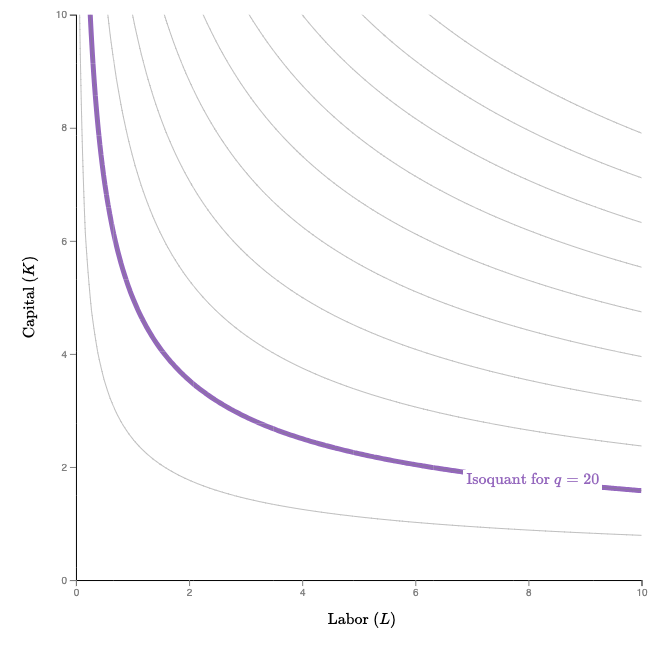pollev.com/chrismakler

Tell me something good.
Technology and
Production Functions
Christopher Makler
Stanford University Department of Economics
Econ 50: Lecture 4
Lecture 2: Production Functions
Labor
Fish
🐟
Capital
Coconuts
🥥
[GOODS]
⏳
⛏
[RESOURCES]
Unit I: Scarcity and Choice
Economics is the study of how
we use scarce resources
to satisfy our unlimited wants
Resources
Goods
Happiness
🌎
⌚️
🤓
Production Functions
A mathematical form describing how much output is produced as a function of inputs.
Labor \((L)\)
Capital \((K)\)
Production Function \(f(L,K)\)
Output (\(q\) or \(x\))
Isoquants
Economic definition: if you want to produce some amount \(q\) of output, what combinations of inputs could you use?
Mathematical definition:
level sets of the production function
Isoquant: combinations of inputs that produce a given level of output
Isoquant map: a contour map showing the isoquants for various levels of output
pollev.com/chrismakler

What happens to isoquants after an improvement in technology?
Marginal Products of Labor and Capital
Economic definition: how much more output is produced if you increase labor or capital?
Mathematical definition:
partial derivatives of the production function
These are both rates: they are measured in terms of units of ouptut per unit of input.
pollev.com/chrismakler

Consider the production function
What is the expression for the marginal product of labor?
Marginal Rate of Technical Substitution (MRTS)
Economic definition:
the rate at which a producer
can substitute one input for another
while keeping output at the same level
Visual definition:
slope of an isoquant
Mathematical definition:
we'll get to this in section and on Friday
Functional Forms
How can different functional forms can be used to model different production processes?


Examples of Production Functions
Linear
Leontief
(Fixed Proportions)
Cobb-Douglas
Constant Elasticity of Substitution (CES)
[50Q only]
Story
If Chuck uses his bare hands (L), he can catch 2 fish per hour.
If Chuck uses a net (K),
he can collect 4 fish per net.
Model
Fish from L hours of labor = 2L
Fish from K nets = 4K
How many fish can he produce altogether if he uses
L hours of labor, and K nets?
Cobb-Douglas Production Function
What story do these marginal products tell us?
When do these functions have diminishing marginal products?
Three Ways to Think About Production
(C) Returns to scale:
keep \(K/L\) constant,
increase \(q\) by scaling up
both labor and capital

(A)
(A) Elasticity of substitution:
keep \(q\) constant,
move along an isoquant
(B)
(B) Short run production function:
keep \(K\) constant,
increase \(q\) by adding labor
(C)
Elasticity of Substitution
- Measures the substitutability of one input for another
- Key to answering the question: "will my job be automated?"
- Formal definition: the inverse of the percentage change in the MRTS
per percentage change in the ratio of capital to labor, K/L - Intuitively: how "curved" are the isoquants for a production function?
CES Production Function
Scaling Production
How does a technology respond to increasing production?
Short run: only some resources can be reallocated
Long run: all resources can be reallocated
It depends on the time horizon:
Scaling Production in the Short Run
Suppose \(K\) is fixed at some \(\overline K\) in the short run.
Then the production function becomes \(f(L\ |\ \overline K)\)
pollev.com/chrismakler

When does the production function
exhibit diminishing marginal product of labor?
Scaling Production in the Long Run
What happens when we increase all inputs proportionally?
For example, what happens if we double both labor and capital?
Does doubling inputs -- i.e., getting \(f(2L,2K)\) -- double output?
Decreasing Returns to Scale
Constant Returns to Scale
Increasing Returns to Scale
Does this exhibit diminishing, constant or increasing MPL?
Does this exhibit decreasing, constant or increasing returns to scale?
pollev.com/chrismakler

When does the production function
exhibit constant returns to scale?
How does this compare to \(2f(L,K)\)?
In other words, does this represent double the output,
more than double the output, or less than double the output produced by \((L,K)\)?
Scaling and the Cobb-Douglas production function
The exponent \(a\) determines if the \(MP_L\) is diminishing, constant, or increasing
The exponent \(b\) determines if the \(MP_K\) is diminishing, constant, or increasing
The sum of the exponents \(a + b\) determines if \(f(L,K)\) exhibits
decreasing, constant, or increasing returns to scale
Summary
So far we've modeled an important economic activity
using multivariable calculus.
We looked at the economic meaning for
various properties of the production function:
Partial Derivatives
Marginal Products
Level Sets
Isoquants
Slope of a Level Set
Marginal Rate of Technical Substitution
In section and on Friday, we'll analyze how
to derivate the slope of an isoquant (MRTS) and a PPF (MRT).
Next time, we'll look at production possibilities for two goods using a PPF model.
Econ 50 | Lecture 04
By Chris Makler
Econ 50 | Lecture 04
Production Functions
- 712



